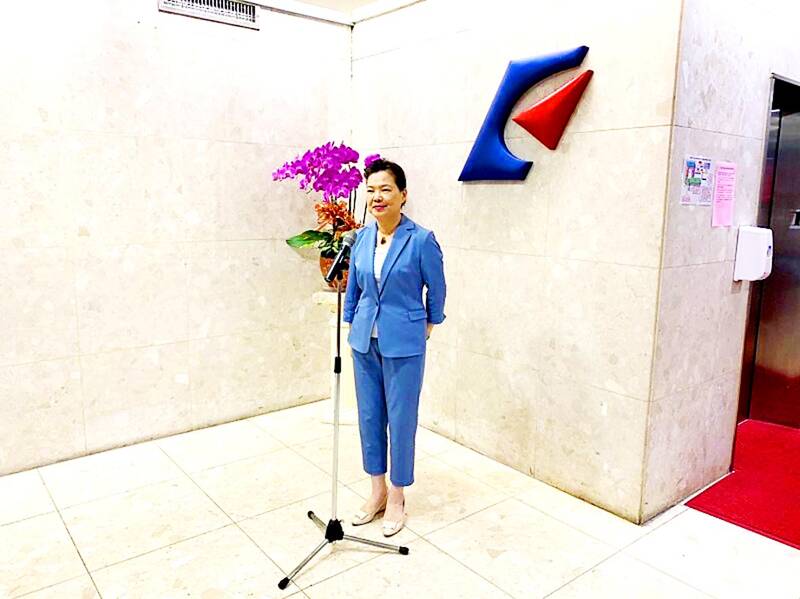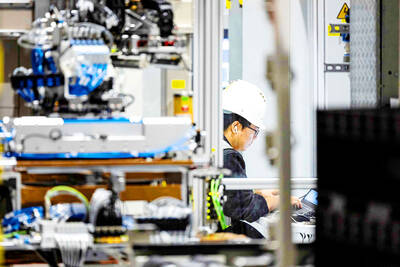Taiwan plans to maintain its energy policy of operating nuclear power reactors until the end of their desinged lifespan, and by using other energy sources to fill gaps in the energy supply, the Ministry of Economic Affairs said yesterday.
“Taiwan will stick to its nuclear power plant timeline. Despite differing opinions, we do not plan to shut down those reactors before of the end of their designed life cycles,” Minister of Economic Affairs Wang Mei-hua (王美花) told reporters in Taipei.
The state-run Taiwan Power Co (Taipower, 台電) has drafted several measures to secure a stable power supply, including electricity allocation plans to manage water shortages caused by climate change and surging energy costs resulting from the war in Ukraine, Wang said.

Photo: Ching Lin, Taipei Times
Japanese Prime Minister Fumio Kishida on Wednesday said that its government is considering using nuclear reactors beyond their designed lifespans along with restarting idled nuclear power reactors to manage a power crisis.
“My understanding is that Japan plans to make some arrangements about the idled reactors that were shut down following the Fukushima disaster in March 2011,” Wang said.
The government has decided to shift from nuclear power and move toward green power to cut carbon emissions.
The No. 2 reactor at Guosheng Nuclear Power Plant is set to stop operation in March next year, while the No. 1 and No. 2 reactors of the Ma-anshan Nuclear Power Plant are to close in 2024 and 2025 respectively, when they are due to reach the end of their operational lives of about 40 years.
Regulations stiputate that any adjustment to nuclear power operations be applied five years in advance, Taipower spokesman Wu Chin-chung (吳進忠) told the Taipei Times.
“The timing has passed,” he said.

CHIP RACE: Three years of overbroad export controls drove foreign competitors to pursue their own AI chips, and ‘cost US taxpayers billions of dollars,’ Nvidia said China has figured out the US strategy for allowing it to buy Nvidia Corp’s H200s and is rejecting the artificial intelligence (AI) chip in favor of domestically developed semiconductors, White House AI adviser David Sacks said, citing news reports. US President Donald Trump on Monday said that he would allow shipments of Nvidia’s H200 chips to China, part of an administration effort backed by Sacks to challenge Chinese tech champions such as Huawei Technologies Co (華為) by bringing US competition to their home market. On Friday, Sacks signaled that he was uncertain about whether that approach would work. “They’re rejecting our chips,” Sacks

It is challenging to build infrastructure in much of Europe. Constrained budgets and polarized politics tend to undermine long-term projects, forcing officials to react to emergencies rather than plan for the future. Not in Austria. Today, the country is to officially open its Koralmbahn tunnel, the 5.9 billion euro (US$6.9 billion) centerpiece of a groundbreaking new railway that will eventually run from Poland’s Baltic coast to the Adriatic Sea, transforming travel within Austria and positioning the Alpine nation at the forefront of logistics in Europe. “It is Austria’s biggest socio-economic experiment in over a century,” said Eric Kirschner, an economist at Graz-based Joanneum

BUBBLE? Only a handful of companies are seeing rapid revenue growth and higher valuations, and it is not enough to call the AI trend a transformation, an analyst said Artificial intelligence (AI) is entering a more challenging phase next year as companies move beyond experimentation and begin demanding clear financial returns from a technology that has delivered big gains to only a small group of early adopters, PricewaterhouseCoopers (PwC) Taiwan said yesterday. Most organizations have been able to justify AI investments through cost recovery or modest efficiency gains, but few have achieved meaningful revenue growth or long-term competitive advantage, the consultancy said in its 2026 AI Business Predictions report. This growing performance gap is forcing executives to reconsider how AI is deployed across their organizations, it said. “Many companies

France is developing domestic production of electric vehicle (EV) batteries with an eye on industrial independence, but Asian experts are proving key in launching operations. In the Verkor factory outside the northern city of Dunkirk, which was inaugurated on Thursday, foreign specialists, notably from South Korea and Malaysia, are training the local staff. Verkor is the third battery gigafactory to open in northern France in a region that has become known as “Battery Valley.” At the Automotive Energy Supply Corp (AESC) factory near the city of Douai, where production has been under way for several months, Chinese engineers and technicians supervise French recruits. “They